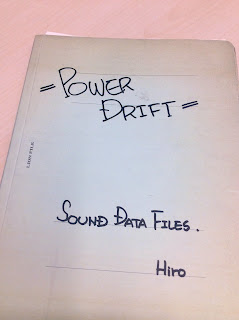In recent years, Sega consolidated its scattered Tokyo offices to a centralised building in Ousaki. One office that closed at the start of 2019 was the Otorii office. This office had been the key development hub since September 1985, shortly after Hang-On development concluded. As such, intriguing development materials were unearthed in the process.
Hiro posted a vast collection of audio planning documents and media from 1985 through to the early 1990s. When Hiro joined Sega in 1984, music was composed on hand-written sheets.
Synthesizers used to compose the melodies included the Yamaha DX-7 for Space Harrier and the Yamaha PSR-70 for AfterBurner. The sheet music was manually transcribed into Macro Music Language for the audio engine to process. This took the format of the note, followed by its length (e.g. C-4, L4, A#4, L8). Once assembled, the actual audio could be tested on hardware. Needless to say this would have been a time consuming process.
For the arcade games of this era, sound comprised lo-fi 8-bit samples used for voices, drums and sound effects. The samples were paired with a YM sound source (typically a Yamaha YM2203 or YM2151 chip), mostly used for melodies. YM sounds could be created and edited with an audio editor, which ensured each game had its own style, despite sharing audio hardware. For example, AfterBurner's 'Final Take Off' uses the YM to drive the melodies, but the overlaid guitars are in fact samples.
Sega Otorii Office Building
Hiro posted a vast collection of audio planning documents and media from 1985 through to the early 1990s. When Hiro joined Sega in 1984, music was composed on hand-written sheets.
Space Harrier Sheet Music. Note that game was called 'Heli' at this stage, as the fantasy theme had not yet been adopted.
Synthesizers used to compose the melodies included the Yamaha DX-7 for Space Harrier and the Yamaha PSR-70 for AfterBurner. The sheet music was manually transcribed into Macro Music Language for the audio engine to process. This took the format of the note, followed by its length (e.g. C-4, L4, A#4, L8). Once assembled, the actual audio could be tested on hardware. Needless to say this would have been a time consuming process.
Hiro's ROM cartridges for the Yamaha DX-7 Synthesizer
For the arcade games of this era, sound comprised lo-fi 8-bit samples used for voices, drums and sound effects. The samples were paired with a YM sound source (typically a Yamaha YM2203 or YM2151 chip), mostly used for melodies. YM sounds could be created and edited with an audio editor, which ensured each game had its own style, despite sharing audio hardware. For example, AfterBurner's 'Final Take Off' uses the YM to drive the melodies, but the overlaid guitars are in fact samples.
Data was saved to 8 inch floppy disks.
The following labels read 'OutRun 2' in reference to the revision of the music, as opposed to being anything to do with OutRun's sequel. I wonder if the earlier revisions of the OutRun music still exist?
OutRun's 'Passing Breeze' was initially named 'Passing Wind', until someone pointed out the flatulence reference. So the disk below must date from the end of the development process!
AfterBurner was aptly referred to as 'Top Gun' during development, and the final audio program code appears to have been named TG.HEX. Some of the disks are dated 9th September 1987.
It appears that data was transferred over the years between 8 inch floppy, through to 5.25 and 3.5 inch floppy for preservation.
Here we can see the list of commands Power Drift's main 68k program code needed to send to the Z80 Sub program in order to trigger the relevant sound.
The final Power Drift master. Later on Digital Audio Tapes (DAT) replaced reel-to-reel recordings.
























No comments:
Post a Comment